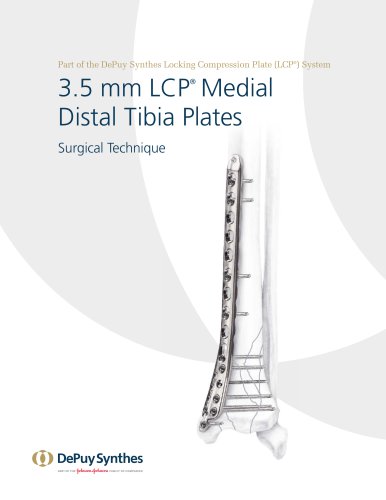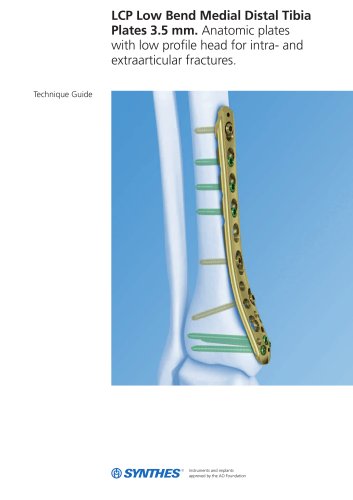
Catalog excerpts

LCP Distal Fibula Plates. Part of the Synthes locking compression plate (LCP) Technique Guide
Open the catalog to page 1
Introduction LCP Distal Fibula Plates 2 Surgical Technique Preoperative Planning 6 Patient Positioning and Approach 8 Product Information Plates 20 This description alone does not provide sufficient background for direct use of the instrument set. Instruction by a surgeon experienced in handling these instruments is highly recommended Reprocessing, Care and Maintenance of Synthes Instruments For general guidelines, function control and dismantling of multi-part instruments, please refer to: www.synthes.com/reprocessing
Open the catalog to page 3
0X6.001.085_AA 05.03.10 13:03 Seite 2 LCP Distal Fibula Plates. Part of the Synthes locking compression plate (LCP) system. The LCP Distal Fibula Plates are part of the Synthes locking compression plate system that merges locking screw technology with conventional plating techniques. The plates are available in stainless steel and titanium. The plates feature an anatomic shape and profile, both distally and along the fibular shaft. The combi-holes in the LCP plate shaft combine a dynamic compression unit (DCU) hole with a locking screw hole. Combi-holes provide maximum flexibility with the...
Open the catalog to page 4
0X6.001.085_AA 05.03.10 13:03 Seite 3 LCP Lateral Distal Fibula Plate Combi-holes in shaft accept 3.5 mm locking screws, 3.5 mm cortex screws, and 4.0 mm cancellous bone screws Five coaxial distal holes accept 2.4 mm and 2.7 mm locking and cortex screws to provide multiple screw options Preshaped design Recesses for screwheads in coaxial holes minimize screw prominence to create a lowprofile construct Four Kirschner wire holes in the head accept 2.0 mm Kirschner wires LCP Posterolateral Distal Fibula Plate Combi-holes in shaft accept 3.5 mm locking screws, 3.5 mm cortex screws, and 4.0 mm...
Open the catalog to page 5
0X6.001.085_AA 05.03.10 13:03 Seite 4 AO Principles In 1958, the AO formulated four basic principles, which have become the guidelines for internal fixation.1, 2 Those principles, as applied to the LCP Distal Fibula Plates are: Anatomic reduction The anatomic plate profile assists with reduction of the distal fibula to the diaphysis and assessment of length, rotation and alignment of the distal fibula. Multiple distal screws at the distal fibula allow maintenance of the articular reduction and stabilization of the distal segment relative to the fibular shaft. Stable fixation The combination...
Open the catalog to page 6
0X6.001.085_AA 05.03.10 13:03 Seite 5 Indications The LCP Distal Fibula Plates are intended for fixation of fractures, osteotomies and non-unions of the metaphyseal and diaphyseal region of the distal fibula, especially in osteopenic bone. Synthes 5
Open the catalog to page 7
Preoperative Planning Note: The techniques for implanting the lateral and postero- lateral distal fibula plates are similar. The following describes implantation of a lateral plate. O Complete the preoperative radiographic assessment and pre- pare the preoperative plan. Determine plate length and distal screw locations to ensure proper plate selection and position, and screw placement in the distal fibula. Required sets LCP Lateral Distal Fibula Plates Set 01.112.072 LCP Lateral Distal Fibula Plates (Stainless Steel), in Modular Tray, Vario Case System 01.112.074 LCP Lateral Distal Fibula...
Open the catalog to page 8
0X6.001.085_AA 05.03.10 13:03 Seite 7 Modular screw rack All screws are available in a modular screw rack which can be arranged as needed. 68.122.020 or 68.122.060 Modular Insert 2/3, for Modular Screw Rack for Screws 3.5/4.0 mm Modular Insert 1/3, for Modular Screw Rack for Screws 3.5 mm 68.122.021 Modular Insert 1/3, for Modular Screw Rack for Screws 2.7/2.4 mm 68.000.113 Screw Rack, size 1/2, for Modular Insert Optional modular small fragment instrument trays 68.122.019 Modular Tray for Small Fragment Bending Instruments 68.122.014 Modular Tray for Small Fragment Reduction Instruments...
Open the catalog to page 9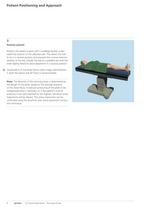
0X6.001.085_AA 05.03.10 13:03 Seite 8 Patient Positioning and Approach 1 Position patient Position the patient supine with a sandbag (bump) underneath the buttock of the affected side. This allows the foot to lie in a neutral position and prevents the normal external rotation of the leg. Elevate the leg on a padded rest with the knee slightly flexed to assist placement in a neutral position. Visualization of the distal fibula under image intensification in both the lateral and AP views is recommended. Note: The direction of the locking screws is determined by the design of the plate, based...
Open the catalog to page 10
0X6.001.085_AA 05.03.10 13:03 Seite 9 2 Approach Make a straight lateral or posterolateral surgical incision to expose the fibular fracture, the distal fibula, and the fibular diaphysis. A lateral incision directly over the fibula can accentuate plate prominence and the wound closure will be directly over the implant. Alternatively, the incision can be placed along the posterolateral border of the fibula where there is improved soft tissue coverage. Be careful not to damage the superficial peroneal nerve proximally and anteriorly, or the sural nerve posteriorly. Deep dissection allows...
Open the catalog to page 11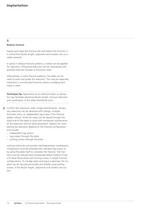
0X6.001.085_AA 05.03.10 13:03 Seite 10 Implantation 1 Reduce fracture Expose and clean the fracture site and reduce the fracture. It is critical that fibular length, alignment and rotation are accurately restored. In spiral or oblique fracture patterns, a clamp can be applied for reduction. Provisional reduction can be maintained with pointed reduction forceps or Kirschner wires. Alternatively, in some fracture patterns, the plate can be used to assist and guide the reduction. This may be especially important in comminuted fractures where a bridging technique is used. Technique tip:...
Open the catalog to page 12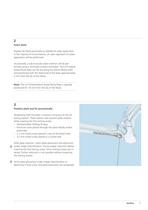
0X6.001.085_AA 05.03.10 13:03 Seite 11 2 Insert plate Expose the fibula proximally as needed for plate application. In the majority of circumstances, an open approach for plate application will be performed. Occasionally, a sub muscular plate insertion will be performed using a minimally invasive technique. The LCP Lateral Distal Fibula Plate can be slid along the lateral fibular shaft and positioned with the distal end of the plate approximately 5 mm from the tip of the fibula. Note: The LCP Posterolateral Distal Fibula Plate is typically positioned 8 – 10 mm from the tip of the fibula. 3...
Open the catalog to page 13All Depuy Synthes catalogs and technical brochures
-
2.0 mm LCP® Distal Ulna Plate
20 Pages
-
Building on Success
16 Pages
-
RADIUS OF CURVATURE
3 Pages
-
Introducing The Variable Angle
12 Pages
-
HEALIX Anchor™ 3.4 mm
2 Pages
-
Small Battery Drive II
4 Pages
-
HEALIX ADVANCE
4 Pages
-
3.5 mm LCP™ Medial
15 Pages
-
Titanium Sternal Fixation System
34 Pages
-
MatrixRIB®FixationSystem
86 Pages
Archived catalogs
-
2.4 mm VA LCP™
4 Pages
-
Mandible Trauma Solutions
2 Pages
-
Power line II
4 Pages
-
Concorde
28 Pages
-
LCP Intercarpal
31 Pages
-
LCS® COMPLETE™
2 Pages
-
Synthes TPLO.
8 Pages
-
SynFix-LR System
56 Pages
-
ATB Anterior Tension Band Plate
32 Pages
-
CONDUIT™
15 Pages
-
Brochure_FINAL
2 Pages
-
DePuy Synthes
81 Pages
-
Anspach
3 Pages
-
Orthopedic Foot Instruments
32 Pages
-
PINNACLE® Hip Solutions
12 Pages
-
Corail
24 Pages
-
S-ROM® NOILES™
68 Pages
-
TRI-LOCK® Product Rationale
12 Pages
-
Reclaim Surgical Technique
44 Pages
-
Speed
2 Pages
-
attune
80 Pages
-
HAMMERLOCK® 2
2 Pages
-
DePuy Glenoid Solutions
2 Pages
-
Trauma Solutions. Elbow
4 Pages
-
Polar
4 Pages
-
Alveolar Distractor.
4 Pages
-
Piezoelectric System
4 Pages
-
Air Power Line II
6 Pages
-
LCP Clavicle Hook Plate
4 Pages
-
TruMatch Pin Guides
16 Pages
-
P F N A
8 Pages
-
SKILL, DEDICATION,
16 Pages
-
Orthopaedics. Overview
20 Pages
-
DURALOC
16 Pages
-
Marathon Cemented Cup
20 Pages
-
REEF Surgical Technique
16 Pages
-
MatrixNEURO
8 Pages
-
Anspach XMax
4 Pages
-
Anspach eMax 2 Plus
4 Pages
-
Small Electric Drive
4 Pages
-
Air Pen Drive
4 Pages
-
Colibri II
4 Pages
-
Spine
25 Pages
-
Expert Hindfoot Arthrodesis Nail
48 Pages
-
TomoFix
60 Pages
-
Expert Tibial Nail PROtect
16 Pages
-
Expert Tibia Nail
84 Pages
-
Sacral Bars
16 Pages
-
Pelvic C-Clamp
20 Pages
-
Low Profile Pelvic System
16 Pages
-
Proximal Femoral (Hook) Plate
24 Pages
-
LCP
24 Pages
-
PFNA
112 Pages
-
HCS 1.5, 2.4, 3.0
36 Pages
-
LCP Wrist Fusion
32 Pages
-
LCP Compact Hand
28 Pages
-
VA-LCP Elbow
48 Pages
-
Distal Radius
44 Pages
-
Olecranon
30 Pages
-
LCP Hook Plate
28 Pages
-
DHP & Olecranon
4 Pages
-
LCP S-A
4 Pages
-
Epoca
4 Pages
-
Philos
32 Pages
-
MultiLoc
68 Pages










